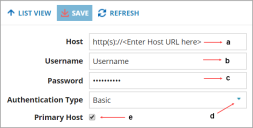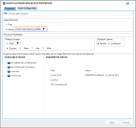Service Manager
This is the latest version of the help for Ivanti Service Manager 2018. If you cannot find some of the features described in the help, you may be using an older version of the application. To upgrade the application, click here.To view the help for the latest version of Service Manager, click here
Ivanti Automation Integration
Ivanti Automation (IA) Integration enables Ivanti Service Manager (ISM) customers to create requests for every day manual tasks like Account Unlock, Reset Password, Computer Provisioning and more. Using the integration of Service Manager with Ivanti Automation, administrators can automate these tasks to remove the manual steps.
Intended Audience
This guide is intended for Service Manager Administrators who are familiar with setting up integrations through the Service Manager Administration UI. Users should also be familiar with the terminology and navigation of the Ivanti Automation Console in order to set up and configure Global Variables, Modules and Run Books.
Prerequisites
•Ivanti Service Manager version 2018.1.x or later
•Ivanti Automation version 2018.1 or later
•Download of the Ivanti Service Manager Utility Connector from the Ivanti Marketplace at the following path: https://marketplace.ivanticloud.com/packages/Ivanti.Service.Manager.Update.Record.Connector/.
•Follow the instructions in the Configuring ISM Utility Connector section (below) to install and configure the connector.
•Ensure the following Global Variables are included in your Ivanti Automation environment (refer to screen shot below):
•Ivanti Service Manager Password: Password to connect to the Service Manager Server.
•Ivanti Service Manager Role: Role of the user to connect to the Service Manager Server
•Ivanti Service Manager Tenant: Tenant that must be connected.
•Ivanti Service Manager Tenant URL: URL of the Service Manager Server that must be connected.
•Ivanti Service Manager UserName: User name to connect to the Service Manager Server.
•Ivanti Automation, version 2018.1 needs to be installed on one of the computers with all the necessary components such as the Console, as well as at least one Dispatcher, and an Agent.
•The Dispatcher WebAPI is disabled by default. You can enable it by enabling the global setting WebAPI state (Setup > Global Settings > Dispatcher WebAPI section) or the setting on Dispatcher-level (Topology > Dispatchers > Settings > Dispatcher WebAPI section).
•When using the Dispatcher WebAPI in your IA environment, it is also possible to secure communication using HTTPS.
Configuring ISM Utility Connector
1.Save the following two files to the Ivanti Automation server:
•Ivanti Service Manager: Go to Ivanti Marketplace and search for Ivanti Service Manager Utility Connector at the following path: https://marketplace.ivanticloud.com/packages/Ivanti.Service.Manager.Update.Record.Connector/
•Ivanti Solution Installer: Download the Ivanti Marketplace Solution installer.exe at the following path: https://marketplace.ivanticloud.com/Tools/Importer
2.Run the Ivanti Package installer. When prompted browse to the location of the Connector installer. It will have a .nupkg extension.
3.Follow the steps of the unpackaging wizard.
4.You may need to close and reopen Ivanti Automation to see the Ivanti Service Manager General task.
By default, integration to Ivanti Automation is enabled for Request Offerings only. Automation can be enabled for additional business objects as required.
Configuring Ivanti Automation in ISM
- Log in to Service Manager and select your role as an Administrator.
- Navigate to MORE..., and under My Workspace, select the Ivanti Automation Configuration workspace.
The Ivanti Automation Configuration workspace is displayed with default values.
•Host: Base URL to access the Automation Server
•Username: Username that is used to access the Automation Server
•Password: Password that is used to access the Automation Server
•Authentication: Type of authentication to connect the Automation Server
•Primary Host: Option to be selected, if it is a primary host for the Automation Server
- Update the configuration details.
- Click Save to save the configuration details.
Configuring and Syncing Run Books
In Ivanti Automation, you can create and configure specific tasks by creating separate modules. These modules are included in Run Books, which can carry out the set of tasks that are needed to be executed for routine IT tasks. Service Manager integration requires the ISM_Transaction and p_status to trigger completed/failed in the Service Manager workflow.
Run Books that have been created must contain defined parameters:
- ISM_TransactionID: RecordID of the Ivanti Automation Transaction Record which will be sent by Service Manager.
- P_Status: Job status that need to be sent back to Service Manager using the Update Record task. When configuring the run book, ensure that the parameter setting on the Input tab new input value “When scheduling job” is unchecked.
When configuring the Run Book in Automation, valid values for P_Status are ‘Completed’ and ‘Failed’. Make sure to enter in one of these two values only.
Once Run Books have been created, they must be synced with Service Manager by completing the following steps:
- Log in to Service Manager and select your role as an Administrator.
- Click the configuration icon
 in the upper right corner.
in the upper right corner. - In the left-hand pane, go to Integration Tools and then select Web Service Connections.
- Scroll down to IVNT_Automation_Runbooks and select the Edit icon
 .
. - Follow the steps to run the Integration process and select Next after each step. Once you are done, select Publish.
You can also schedule this to run every day/hours by defining the schedule entry.
Verifying the Synced Run Books
- Back in Service Manager, leave the Administration UI and from the client UI, open the Request Offering workspace.
- Click Account Unlock to open this Request Offering.
- Select the Plan Request FulFillment Tab.
- Double-click the Ivanti Automation block in the workflow.
The Ivanti Automation Block Properties dialog box opens.
The Value drop-down list shows all the Run Books that have been created.
- Select the appropriate Run Book for this particular task and click Save.
If the synced run books do not appear; give the process a minute or two to complete. If run books still do not appear in the drop down, refer to the Troubleshooting section (below) to review the logs that will help guide you in verifying settings. Once complete, re-run the process to sync run books.
Configuring Ivanti Automation Block Properties
- Log in to Service Manager and select your role as an Administrator.
- Navigate to MORE..., and under My Workspace, select the Request Offering workspace.
- From the list available, select the desired Request Offering.
- Select the Plan Request Fulfillment tab.
- From the Fulfill as: list, the Workflow option is selected by default.
- Navigate to Integration, and then double-click the Ivanti Automation block in the workflow.
The Ivanti Automation Block Properties dialog box opens.
- Depending on the Run Books created in the Ivanti Automation Tool, add or edit the required parameters. For example, for account unlock, only the p_username parameter is required.
In the example below, a service request variable was used as the p_username parameter.
No values are required for p_status or ISM_TransactionID.
- Click Save to save the parameters.
- Click Save on the page to save the entire request offering.
Troubleshooting
If your Run Book does not execute as planned or the workflow does not execute properly, there are a number of areas you can go to troubleshoot.
Viewing the Automation Transaction Business Object
Ivanti Automation Transaction - This business object logs all the transactions that have been carried out particular to this integration. This provides the status of the job and the logs related to a particular transaction.
Viewing the Integration Log
To view the details of the processed job, you can view the Integration Log workspace.
- Log in to Service Manager using the Administrator role.
- Open the Integration Log workspace.
- To open the workspace, select More > Integration Log.
- From the Integration Log workspace, view the information in the columns for the list of logs or open a record to view details.
Viewing the Integration Queue
While the job is being processed, you can view the record from the Integration Queue workspace.
After the job is processed, the record will not be available from the Integration Queue workspace. You can then view it from the Integration Log workspace.
- Log in to Service Manager using the Administrator role.
- Open the Integration Queue workspace.
- To open the workspace, select More > Integration Queue. The workspace will be empty when there are no records to process.
- When the record appears in Queued Status in the Integration Log workspace, then the record appears while it is being processed in the Integration Queue workspace.
Was this article useful?
The topic was:
Inaccurate
Incomplete
Not what I expected
Other
Copyright © 2018, Ivanti. All rights reserved.




